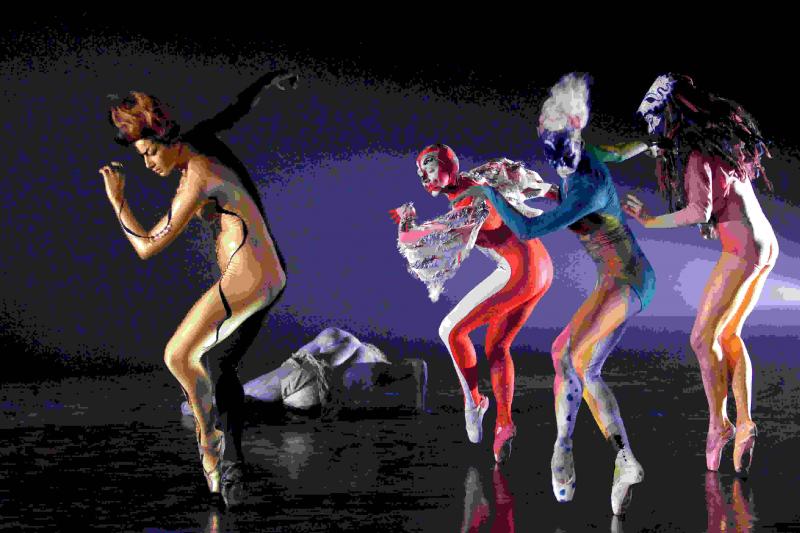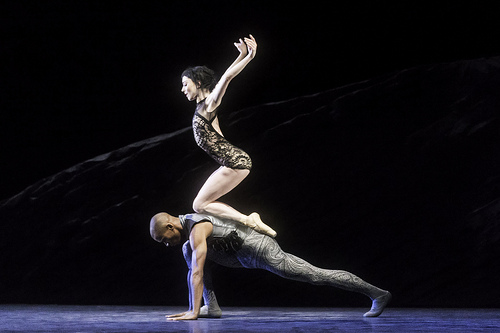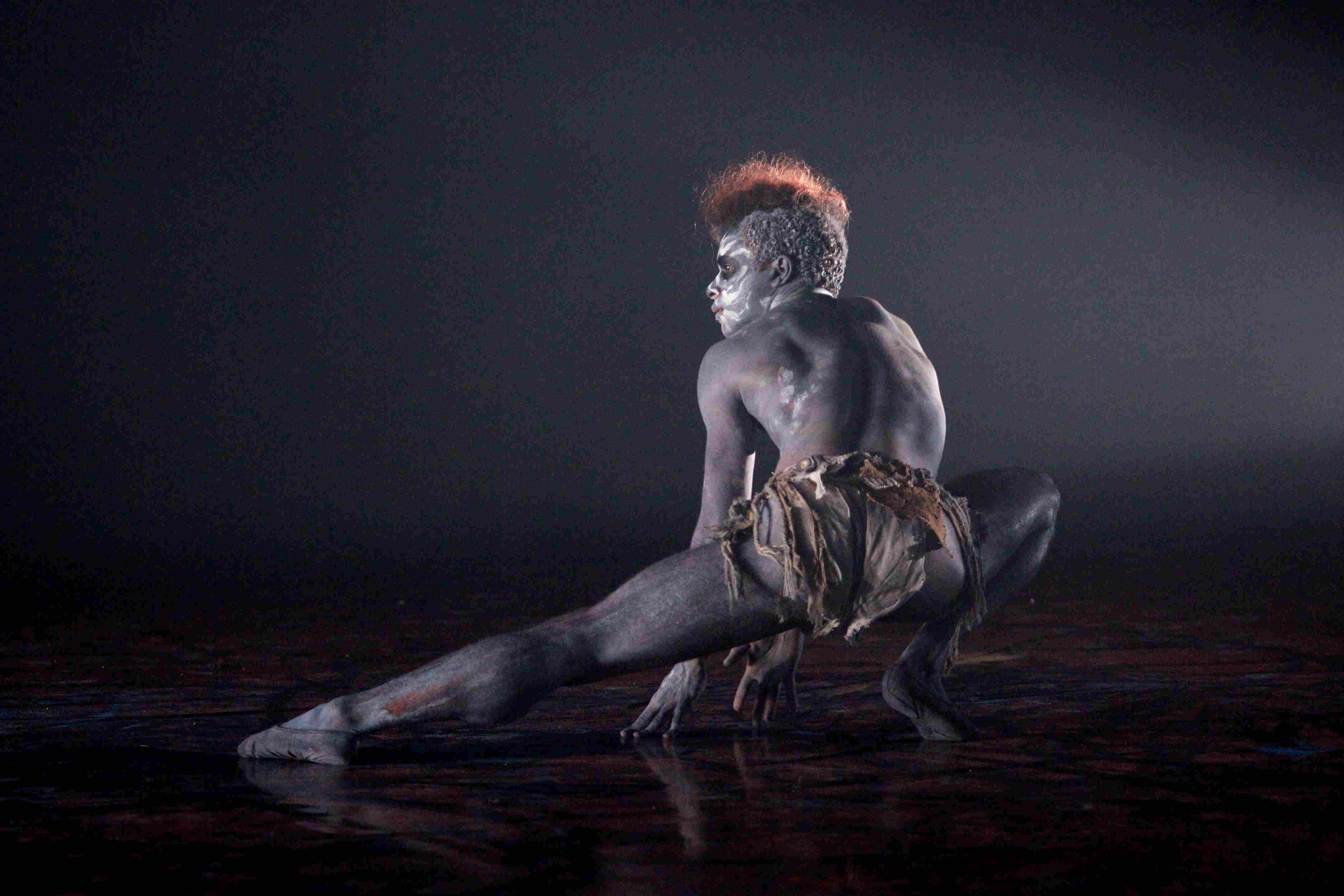Sampling the Myth, Royal Ballet | reviews, news & interviews
Sampling the Myth, Royal Ballet
Sampling the Myth, Royal Ballet
Mixture of old and new makes for a colourful journey through mythology

The Royal Opera House is on fire this month. Not literally (unless someone knocks over the flaming braziers outside) but with the varied illuminations of the Deloitte Ignite Festival, co-curated by the Royal Ballet and Minna Moore Ede of the National Gallery. The theme this year is Myth, and specifically Leda's rape by Zeus in swan form, and Prometheus's gift of fire to humanity.
The various extracts from existing pieces are – with one exception – well chosen, and boast a remarkable array of principals. We got the encounter between the Tsarevich (Bennet Gartside) and the Firebird (Roberta Marquez) from the ballet of the same name, the Dying Swan solo (Marianela Nuñez), the lyre solo from Apollo (Federico Bonelli), the final moments from Ondine (Yuhui Choe and Valeri Hristov), and the pas de deux between the Prince (Liam Mower) and the Lead Swan (Edward Watson) from Matthew Bourne’s Swan Lake. All were done well, with the standouts being Nuñez’s swan and the Ondine excerpt, which brilliantly showcased Ashton’s genius for embedding concise storytelling in his steps, rather than hanging the one on the other.
 The pas de deux of the Raven Girl (Sarah Lamb) and the Raven Prince (Eric Underwood) from Wayne McGregor’s Raven Girl (pictured right) was my exception to the good choices. Though it’s a moment of rare emotion in the context of the rest of the work, isolating it here exposes how close to sadistic its hyper-contorted choreography is. Lamb and Underwood execute the difficult moves flawlessly, but with barely a flicker of warmth or emotion. Raven Girl, which is neither a myth nor a fairytale but a Kafka-esque fable, shows the impossibility of creating new myths in the 21st century; its story of highly individuated unhappiness sits uneasily beside the rest of the evening’s offerings from the tropes and types of classical mythology and 19th-century supernatural fantasy.
The pas de deux of the Raven Girl (Sarah Lamb) and the Raven Prince (Eric Underwood) from Wayne McGregor’s Raven Girl (pictured right) was my exception to the good choices. Though it’s a moment of rare emotion in the context of the rest of the work, isolating it here exposes how close to sadistic its hyper-contorted choreography is. Lamb and Underwood execute the difficult moves flawlessly, but with barely a flicker of warmth or emotion. Raven Girl, which is neither a myth nor a fairytale but a Kafka-esque fable, shows the impossibility of creating new myths in the 21st century; its story of highly individuated unhappiness sits uneasily beside the rest of the evening’s offerings from the tropes and types of classical mythology and 19th-century supernatural fantasy.
Of the three short dance films, all dealing with Leda and the Swan, Kim Brandstrup’s was the standout, picking up on the complexities of divine-mortal union by intercutting two poems by WB Yeats, "Leda and the Swan" and "The Mother of God". Tommy Franzen and Royal Ballet dramatic heavyweight Zenaida Yanowsky dance with each other on top of a stone block that could be a bed, a tomb or an altar, and there are two distinct sections, with each getting a chance to project desire, aggression, and submission. The “flying” with which both sections end is a masterstroke – sexy, unsettling, and unforgettable.
The two new pieces, both essentially contemporary in style, eschewed swans and spirits in favour of more primal and elemental mythical material. Miguel Altunaga, one of Rambert’s most electric dancers, had cast himself and two Rambert colleagues, Estella Merlos and Hannah Rudd, as the Fates in a piece called Dark Eye that fizzed with energy and atmosphere. The dark blankness of the Linbury stage was turned into an advantage, a suggestion of the vast, gloomy cavern we imagine the Fates to inhabit, while ingenious downward spotlighting created the illusion of grey, rainy landscapes for the sisters to journey through. A low-to-the-ground flexible contemporary choreographic language, more “natural” than ballet, fits perfectly with the idea of the Fates, who come before anyone, even the gods. Twisting, writhing, crawling, exploding apart, then coming together in witchy communion, and making a feature of white, claw-like hands against their dark cloaks, the three dancers were mesmerising, and the piece as a whole highly successful. It’s a simple conceit – effectively an atmosphere piece exploring the weirdness of these mythical beings – but executed brilliantly.
 Aakash Odedra’s piece, Unearthed, suffered from a dire lack of simplicity. A take on the Prometheus myth, it featured a creator figure (Prometheus?), who at one point dug his hands into a pile of clay, a dancer representing his creation (homo faber? Human culture?), and six dancers representing different aspects of fire. I learned more about these latter from Marina Warner’s commentary at the beginning than from the piece itself: in garish costumes (main picture) painted by Chris Ofili (in some cases directly onto their skin), they looked like hideous X-Men and had very little of interest to do, dance-wise. The grey, black and white costumes of Prometheus and Man, whose dotted and daubed patterns suggested African and aboriginal witch doctors, were more evocative, and those two characters also had more weight to their choreography – Marcelino Sambé's Man (pictured above left) in particular a tour de force of intensity.
Aakash Odedra’s piece, Unearthed, suffered from a dire lack of simplicity. A take on the Prometheus myth, it featured a creator figure (Prometheus?), who at one point dug his hands into a pile of clay, a dancer representing his creation (homo faber? Human culture?), and six dancers representing different aspects of fire. I learned more about these latter from Marina Warner’s commentary at the beginning than from the piece itself: in garish costumes (main picture) painted by Chris Ofili (in some cases directly onto their skin), they looked like hideous X-Men and had very little of interest to do, dance-wise. The grey, black and white costumes of Prometheus and Man, whose dotted and daubed patterns suggested African and aboriginal witch doctors, were more evocative, and those two characters also had more weight to their choreography – Marcelino Sambé's Man (pictured above left) in particular a tour de force of intensity.
The arc was some kind of creation story, but the slow opening (clearly the “without form, and void” part) was far too long, a tedious exercise in enduring white noise (Talvin Singh’s score) and waiting for something to happen. The suggestions of primordialism, the (eventually) percussive score and the stamping-based choreography all make inevitable comparison with the Rite of Spring, but only to Unearthed’s disadvantages: it succeeds in being neither profound nor exciting. I’d have expected better from Odedra, a talented and thoughtful young choreographer, but I wonder whether – like 2012’s Diana and Actaeon (coincidentally also boasting garish unitards by Ofili) – there were too many cooks involved and the broth got overboiled.
Though Marina Warner's narration offered some interesting facts and observations, particularly about birds (which seem to be a love of hers), Sampling the Myth was clearly intended to be less a profound exploration of the nature of these stories than simply a joyful introduction to the fertile worlds of both myth and dance. In that, it succeeded admirably.
- The Deloitte Ignite Festival runs at the Royal Opera House until 28 September
rating
Share this article
The future of Arts Journalism
You can stop theartsdesk.com closing!
We urgently need financing to survive. Our fundraising drive has thus far raised £49,000 but we need to reach £100,000 or we will be forced to close. Please contribute here: https://gofund.me/c3f6033d
And if you can forward this information to anyone who might assist, we’d be grateful.

Subscribe to theartsdesk.com
Thank you for continuing to read our work on theartsdesk.com. For unlimited access to every article in its entirety, including our archive of more than 15,000 pieces, we're asking for £5 per month or £40 per year. We feel it's a very good deal, and hope you do too.
To take a subscription now simply click here.
And if you're looking for that extra gift for a friend or family member, why not treat them to a theartsdesk.com gift subscription?
more Dance
 'We are bowled over!' Thank you for your messages of love and support
Much-appreciated words of commendation from readers and the cultural community
'We are bowled over!' Thank you for your messages of love and support
Much-appreciated words of commendation from readers and the cultural community
 R:Evolution, English National Ballet, Sadler's Wells review - a vibrant survey of ballet in four acts
ENB set the bar high with this mixed bill, but they meet its challenges thrillingly
R:Evolution, English National Ballet, Sadler's Wells review - a vibrant survey of ballet in four acts
ENB set the bar high with this mixed bill, but they meet its challenges thrillingly
 Like Water for Chocolate, Royal Ballet review - splendid dancing and sets, but there's too much plot
Christopher Wheeldon's version looks great but is too muddling to connect with fully
Like Water for Chocolate, Royal Ballet review - splendid dancing and sets, but there's too much plot
Christopher Wheeldon's version looks great but is too muddling to connect with fully
 iD-Reloaded, Cirque Éloize, Marlowe Theatre, Canterbury review - attitude, energy and invention
A riotous blend of urban dance music, hip hop and contemporary circus
iD-Reloaded, Cirque Éloize, Marlowe Theatre, Canterbury review - attitude, energy and invention
A riotous blend of urban dance music, hip hop and contemporary circus
 How to be a Dancer in 72,000 Easy Lessons, Teaċ Daṁsa review - a riveting account of a life in dance
Michael Keegan-Dolan's unique hybrid of physical theatre and comic monologue
How to be a Dancer in 72,000 Easy Lessons, Teaċ Daṁsa review - a riveting account of a life in dance
Michael Keegan-Dolan's unique hybrid of physical theatre and comic monologue
 A Single Man, Linbury Theatre review - an anatomy of melancholy, with breaks in the clouds
Ed Watson and Jonathan Goddard are extraordinary in Jonathan Watkins' dance theatre adaptation of Isherwood's novel
A Single Man, Linbury Theatre review - an anatomy of melancholy, with breaks in the clouds
Ed Watson and Jonathan Goddard are extraordinary in Jonathan Watkins' dance theatre adaptation of Isherwood's novel
 Peaky Blinders: The Redemption of Thomas Shelby, Rambert, Sadler's Wells review - exciting dancing, if you can see it
Six TV series reduced to 100 minutes' dance time doesn't quite compute
Peaky Blinders: The Redemption of Thomas Shelby, Rambert, Sadler's Wells review - exciting dancing, if you can see it
Six TV series reduced to 100 minutes' dance time doesn't quite compute
 Giselle, National Ballet of Japan review - return of a classic, refreshed and impeccably danced
First visit by Miyako Yoshida's company leaves you wanting more
Giselle, National Ballet of Japan review - return of a classic, refreshed and impeccably danced
First visit by Miyako Yoshida's company leaves you wanting more
 Quadrophenia, Sadler's Wells review - missed opportunity to give new stage life to a Who classic
The brilliant cast need a tighter score and a stronger narrative
Quadrophenia, Sadler's Wells review - missed opportunity to give new stage life to a Who classic
The brilliant cast need a tighter score and a stronger narrative
 The Midnight Bell, Sadler's Wells review - a first reprise for one of Matthew Bourne's most compelling shows to date
The after-hours lives of the sad and lonely are drawn with compassion, originality and skill
The Midnight Bell, Sadler's Wells review - a first reprise for one of Matthew Bourne's most compelling shows to date
The after-hours lives of the sad and lonely are drawn with compassion, originality and skill
 Ballet to Broadway: Wheeldon Works, Royal Ballet review - the impressive range and reach of Christopher Wheeldon's craft
The title says it: as dancemaker, as creative magnet, the man clearly works his socks off
Ballet to Broadway: Wheeldon Works, Royal Ballet review - the impressive range and reach of Christopher Wheeldon's craft
The title says it: as dancemaker, as creative magnet, the man clearly works his socks off
 The Forsythe Programme, English National Ballet review - brains, beauty and bravura
Once again the veteran choreographer and maverick William Forsythe raises ENB's game
The Forsythe Programme, English National Ballet review - brains, beauty and bravura
Once again the veteran choreographer and maverick William Forsythe raises ENB's game

Add comment